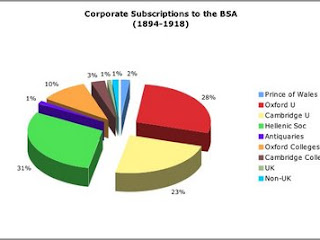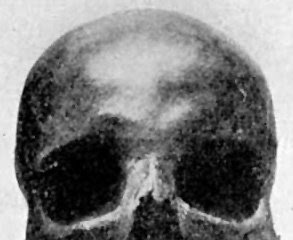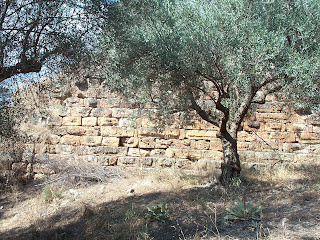Folklore was an element of student research. The Cambridge emphasis can probably be traced back to J.G. Frazer (himself a student at the BSA) and to William Henry Denham Rouse (1863-1950). One of the earliest discussions is by Edward E. Sikes of St John’s, who worked on folklore elements in Hesiod in the early 1890s. Sikes drew on contemporary folklore studies and interpretations. John C. Lawson of Pembroke College was interested in the traditions of Skyros, and studied ‘folk-lore and traditional beliefs of the Greek people’ drawing on ‘oral as well as literary sources’. F.W. Hasluck of King’s College collected folk-lore traditions in Anatolia. R.M. Dawkins of Emmanuel College recorded folk-tales and noted carnivals. A.J.B. Wace also collected folk-tales and reworked them in a series of short-stories. One of the few non-Cambridge students to work in this area was Mary Hamilton of St Andrews, who researched Greek saints and explored continuity from pre-Christian times.
Select bibliographyCasson, S. 1913. "The dispersal legend."
Classical Review 27: 153-56. [
JSTOR]
—. 1927. "The growth of legend."
Folklore 38: 255-71. [
JSTOR]
Dawkins, R. M. 1904. "Greek and Cretan epiphany customs."
Folklore 15: 214. [
JSTOR]
—. 1924a. "Ancient statues in mediaeval Constantinople."
Folklore 35: 209-48.
[
JSTOR]
—. 1924b. "Ancient statues in mediaeval Constantinople: additional note."
Folklore 35: 380.
—. 1929. "Presidential address: folklore and literature."
Folklore 40: 14-36.
[
JSTOR]
—. 1930. "Presidential address: folk-memory in Crete."
Folklore 41: 11-42.
[
JSTOR]
—. 1942a. "Folklore in stories from the Dodecanese."
Folklore 53: 5-26. [
JSTOR]
—. 1942b. "Soul and body in the folklore of modern Greece."
Folklore 53: 131-47.
[
JSTOR]
—. 1944. "A modern Greek folktale and comments."
Folklore 55: 150-61. [
JSTOR]
—. 1949a. "The story of Griselda."
Folklore 60: 363-74. [
JSTOR]
—. 1949b. "Obituary: Margaret Masson Hasluck."
Folklore 60: 291-92. [
JSTOR]
—. 1951. "The meaning of folktales." Folklore 62: 417-29. [
JSTOR]
—. 1951b. "Obituary: W. H. D. Rouse."
Folklore 62: 269-70. [
JSTOR]
—. 1951c. "Recently published collections of modern folktales."
Annual of the British School at Athens 46: 53-60.
—. 1952. "The silent princess."
Folklore 63: 129-42. [
JSTOR]
—. 1953a. "In a Greek village."
Folklore 64: 386-96. [
JSTOR]
—. 1953b.
Modern Greek Folktales. Oxford: Clarendon Press.
Halliday, W. R. 1910a. "The force of initiative in magical conflict."
Folklore 21: 147-67. [
JSTOR]
—. 1910b. "A spitting cure."
Folklore 21: 388. [
JSTOR]
—. 1912a. "A Greek Marriage in Cappadocia."
Folklore 23: 81-88. [
JSTOR]
—. 1912b. "Folklore scaps from Greece and Asia Minor."
Folklore 23: 218-20. [
JSTOR]
—. 1912c. "Modern Greek folk-tales and ancient Greek mythology."
Folklore 23: 486-89. [
JSTOR]
—. 1913. "Cretan folklore notes."
Folklore 24: 357-59. [
JSTOR]
—. 1914. "Modern Greek folk-tales and ancient Greek mythology: Odysseus and Saint Elias."
Folklore 25: 122-25. [
JSTOR]
—. 1919. "A sailor's saying."
Folklore 30: 316-17. [
JSTOR]
—. 1920. "Obituary: F.W. Hasluck."
Folklore 31: 336-38. [
JSTOR]
—. 1920. "The story of Ali Baba and the Forty Thieves."
Folklore 31: 321-23. [
JSTOR]
—. 1921. "Snake stones."
Folklore 32: 262-71. [
JSTOR]
—. 1922. "Snake stones."
Folklore 33: 118-19. [
JSTOR]
—. 1923. "Notes upon Indo-European folk-tales and the problem of their diffusion."
Folklore 34: 117-40. [
JSTOR]
—. 1924a.
Folklore studies: ancient and modern. London: Methuen.
—. 1924b. "Passing under the yoke."
Folklore 35: 93-95. [
JSTOR]
—. 1924c. "The Mithraic grade of "Eagles"."
Folklore 35: 381. [
JSTOR]
—. 1930. ""The Superstitious Man" of Theophrastus."
Folklore 41: 121-53. [
JSTOR]
—. 1933.
Indo-European folk-tales and Greek legend. Gray lectures; 1932. Cambridge: The University Press.
—. 1950. "A motif found in Moslem legend."
Folklore 61: 218. [
JSTOR]
Hasluck, F. W. 1911/12. "Plato in the folk-lore of the Konia plain."
Annual of the British School at Athens 18: 265-69.
—. 1912/13. "Studies in Turkish history and folk-legend."
Annual of the British School at Athens 19: 198-220.
—. 1919. "Prentice Pillars: the architect and his pupil."
Folklore 30: 134-35. [
JSTOR]
Hasluck, F.W. (eds. M.M. Hasluck, R. M. Dawkins). 1926.
Letters on religion and folklore. London: Luzac & Co.
Hasluck, F. W. (ed. M. M. Hasluck). 1929.
Christianity and Islam under the Sultans. Oxford: Clarendon Press.
Hasluck, M.M. ‘The significance of Greek personal names’,
Folklore 34, 2 (1923) 149-154, 249-251. [
JSTOR]
—. 1925. "Ramadan as a personal name."
Folklore 36: 280. [
JSTOR]
—. 1926. "A lucky spell from a Greek island."
Folklore 37: 195-96. [
JSTOR]
—. 1927. "The basil-cake of the Greek New Year."
Folklore 38: 143-77. [
JSTOR]
—. 1949. "Oedipus Rex in Albania."
Folklore 60: 340-48. [
JSTOR]
Lawson, J. C. 1910.
Modern Greek Folklore and Ancient Greek Religion: a study in survivals. Cambridge: Cambridge University Press.
Sikes, E. E. 1893. "Folk-Lore in the 'Works and Days' of Hesiod."
Classical Review 7: 389-94. [
JSTOR]
—. 1909. "Four-footed man: a note on Greek anthropology."
Folklore 20: 421-31. [
JSTOR]








